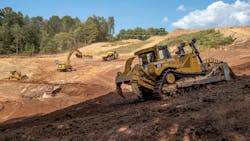Kwest Group won its first Fleet Masters Award in 2020. The celebration was short-lived, though, when the emerging Covid-19 pandemic forced an abrupt end to Conexpo, where the AEMP Connect conference had been held. The Kwest equipment team made a vow to do it all again in 2023, the next time AEMP Connect would be co-located with Conexpo.
The Kwest equipment team returned to Las Vegas to celebrate the accomplishment of its goal, having been named the small-fleet (<$100 million estimated replacement value) winners of the 2023 Construction Equipment and AEMP Fleet Masters Award.
Click here for information on the 2024 nomination process.
“Our team has made big strides over the last three years,” says Chad McKee, CEM, equipment operations manager. “Everything we do is driven by customer service. Our field staff are our customers, and we’re always striving to make sure they are taken care of.”
In addition to McKee, the Kwest equipment team includes Brooke Speiser, CEM, equipment operations coordinator; Adam Turner, field operations coordinator; and Terry Perry, DOT logistics coordinator. Seamless communication between all four has been key to delivering superior service.
Over the past two years, Kwest has implemented a custom-built software application created by in-house developers. The software makes it easy to track and schedule not only equipment, but also DOT moves and attachments.
“We’ve focused on bringing our individual departments together so nobody falters in any way,” Speiser says. “Thanks to this new software, everything is there in black and white for all of us to see. And the information comes directly from the field, so we know exactly what crews need and when. That makes it seamless for all of us to execute.”
Kwest Group is a civil construction and environmental services firm. The company performs work throughout the country with two offices in Ohio and one in Texas, along with a newly opened facility in Roanoke, Virginia.
“As our footprint has continued to grow, we as an equipment team remain focused on doing everything we can to maintain the level of customer service we provide,” McKee says.
To that end, the equipment team has undertaken several campaigns over the past couple of years to help improve efficiency, accuracy, and accountability.
Equipment shop organization
Kwest Group’s board of directors, which includes McKee, identified a strategic corporate objective of implementing 5S in the equipment department. 5S is a lean management methodology for creating a more organized and efficient workspace. In the case of Kwest Group, 5S would be applied to the equipment shops.
McKee tapped Turner to oversee implementation. Turner worked with his team to clean and declutter the shops. An equipment team meeting was also held to discuss shop organization and work processes.
That initial phase of 5S implementation resulted in an almost immediate improvement in speed and efficiency. “Simply by cleaning up and getting rid of some unneeded inventory, our team has been able to respond much faster to requests coming in from the field,” McKee says.
The fervor for 5S has now spilled over to other facets of the equipment department. Speiser has even revamped some of her processes as equipment coordinator. For example, she has always had a process for tracking equipment, but it was clumsy and prone to confusion, due to its reliance on texts, emails, and phone calls between departments. Now everyone is using the custom software application, including the foremen, to monitor where equipment is and how it is being utilized.
Digital equipment inspections
The Kwest equipment team has also been leveraging technology to streamline another historically clumsy process. The migration to digital equipment inspections started in 2020, but an important step has been added in recent months.
Five photos are now required with every inspection. Drivers and operators use their smartphones to take the photos and complete the inspections. Foremen review the inspections on their tablets.
“Pictures help tell the story, which helps the operator save time when filling out their inspection form,” McKee says. “Pictures also allow us to establish accountability if there is equipment damage. We are also able to better manage maintenance items because our maintenance request forms are based on deficiencies found in the inspection forms.”
“If there ever is a discrepancy in a maintenance request, it helps to go back and look at the photos,” Speiser adds. All past inspections are searchable by various criteria including job, operator, equipment ID.
The new inspection process also has aided in tracking service. For example, if an invoice comes through for a certain part, it’s easy to look up that machine’s inspection forms and maintenance requests to confirm that the correct maintenance was performed on that machine.
Stronger dealer relationships
One other benefit of the new inspection process is that the forms and photos can easily be forwarded to vendors. This is becoming increasingly necessary as Kwest Group takes on projects throughout the country, making it impractical for the company’s locally based technicians to efficiently service all equipment.
“If we have an out-of-state job that’s heavy on equipment, I’ll reach out to the area dealers in advance,” Speiser says. “Because we have that relationship in place, most dealers are usually pretty good about going by the sites once in a while to make sure everything is OK.”
Case in point, Kwest Group was recently working on a project in North Carolina with seven owned pieces and one rental, all of the same brand.
“When we signed the rental agreement, I’d asked for the names and numbers of the dealer’s field maintenance technicians, which the dealer was more than happy to provide,” Speiser says. “The service we get from our dealer partners has been great. And again, it’s because we work hard to build those relationships upfront.”
“Those of us at Kwest Group are just bricks in the wall,” McKee adds. “Our partners are the mortar that holds those bricks together. We mention communication a lot, but that’s really what forms these partnerships and helps keep the wall standing.”
Telematics triggers faster service
Whether leaning on dealer partners or in-house technicians, Kwest’s equipment maintenance is using machine data to play a bigger role. The equipment team had been leveraging data on machine location and utilization for years, but is now adding diagnostic fault codes to the mix.
When a machine throws off a fault code, text alerts are sent to both Speiser and her in-house technicians. If an issue is more complex than the in-house technicians can handle, Speiser forwards it to the dealer. She’ll also send any photos and inspection forms that help describe the situation.
“In either case, this helps the technician prepare for what’s coming their way,” Speiser says. “If a piece of equipment throws a fault code, there’s a good chance we’ll see a maintenance request in a day or two. A technician can start planning accordingly by figuring out what parts will be needed. That helps ensure that the equipment will be serviced as quickly as possible.”
Rates structured on costs
The Kwest equipment team has also been playing an active role in helping the company achieve its financial goals. That has involved stronger collaboration with departments outside of the equipment team. For instance, the equipment and estimating teams worked together to develop a new internal rate structure. It’s a two-rate structure consisting of ownership and operating costs.
“We examined historical data on our ‘operated’ and ‘standby’ hours for each class of equipment,” Speiser says. “The two-rate structure allows us to charge a full ‘operating rate’ when a piece of equipment is actually being used, or a ‘standby rate’ when a unit is located to a project, but just sitting idle. The standby rate is our way of accounting for underutilization and ownership costs.”
The intent of the two-rate structure is twofold. First, being able to charge jobs a standby rate has helped improve utilization. Second, the analysis of historical equipment cost data has led to a more accurate rate structure based on true utilization. “This has allowed us to increase competitiveness at the bid table, while simultaneously allowing us to better manage our internal equipment costs,” Speiser says.
The Kwest equipment team has also ramped up collaboration with the accounting department and has added its own dedicated accountant.
“This will help us track and dissect our costs in a more detailed way, which will further help us with budgeting, lifecycle cost management, and how we go about charging for different pieces of equipment,” Speiser says.
The Kwest equipment team accomplished much over the past three years, but McKee and Speiser say they are not stopping here. Kwest Group is celebrating its 20th anniversary this year, and it is focused on moving the company forward. The equipment team will continue playing a pivotal role in maintaining that momentum.
Nineteen years of promoting equipment management excellence
AEMP and Construction Equipment have partnered to highlight the very best construction fleets in the world for almost 20 years.
Our continued focus on honoring these men and women who manage these assets is a crucial part of our thriving equipment management career sector.
The profession is changing at the speed of light through innovation, technology, and improved efficiencies, and the role of these dedicated professionals is being elevated within companies across the industry.
AEMP and Construction Equipment stand together firmly dedicated to ensure that these stellar efforts are recognized each year so other fleet teams can learn from exemplary operations.
The Fleet Masters articles and interviews in CE highlight effective fleet management tactics and strategies that can benefit all equipment managers. This is just one way the Fleet Masters Award will continue to drive the industry forward for years to come. For more information, visit www.ConstructionEquipment.com/fleet-masters.




